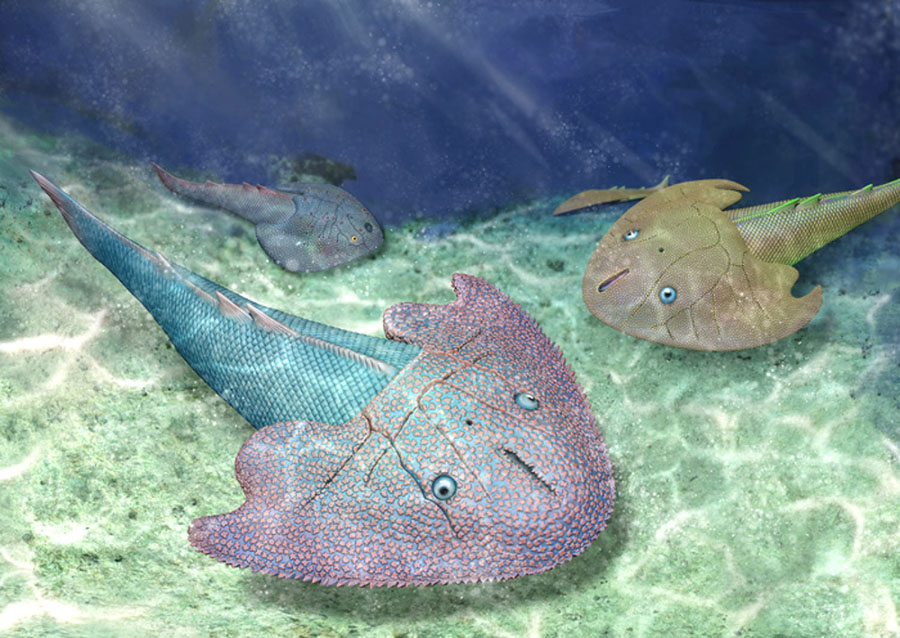Nochelaspis maeandrine: Early Devonian Fish Had Triangular Head Shield

Paleoichthyologists in China have re-described Nochelaspis maeandrine, a species of large-sized eugaleaspiform fish that lived 415 million years ago (Devonian period).
Nochelaspis maeandrine was first described in 1987 from a nearly complete head shield found in the Xishancun Formation near Qujing City, Yunnan Province, southwestern China.
The ancient jawless fish belongs to the order Eugaleaspidiformes in the class Galeaspida.
“The jawless armored galeaspids thrived in the Siluro-Devonian period, but were strictly restricted in China and northern Vietnam,” said Dr. Min Zhu, a paleoichthyologist in the Institute of Vertebrate Paleontology and Paleoanthropology at the Chinese Academy of Sciences, and his colleagues.
“They are among the enigmatic clades of stem-gnathostomes for understanding the transition from jawless to jawed vertebrates.”
“As one of three major groups of Galeaspida, Eugaleaspiformes diverged from the basal galeaspids as early as the middle Telychian, Llandovery of Silurian.”
“To our knowledge, the largest eugaleaspiform is Nochelaspis maeandrine from the bottom of the Xishancun Formation,” they added.
“However, it remains poorly known in its morphology and taxonomy because of the scarcity of material.”
In the new research, the paleoichthyologists examined two new specimens of Nochelaspis maeandrine — two incomplete head shields and two complete cornual and inner cornual processes of head shield — from two localities of the Xishancun Formation.
“The two new specimens redefined the characteristics of Nochelaspis maeandrine, including its triangular head shield, slit-like median dorsal opening with a sawtooth-like edge, dermal ornamentations composed of coarse stellate tubercles, and a more robust inner cornual process with the posterior end far beyond the posterior margin of the cornual process,” they explained.
“Moreover, the new specimens unraveled the mystery of the ventral side of the head shield in Nochelaspis maeandrine for the first time.”
“The head shield curves ventrally to form a flat ventral rim, embracing a large pear-shaped oralobranchial fenestra. The branchial fenestra is covered by a ventral plate.”
“There are six pairs of successive round branchial openings symmetrically aligned along the lateral margins of the branchial fenestra.”
“The mouth is assumed to be located at the front end of the oralobranchial fenestra.”
“The ventral plate of Nochelaspis maeandrine is large enough to have close contact with the ventral rim to shape the branchial openings.”
“The new evidence suggests that the pouch-like gills of Nochelaspis maeandrine open to the exterior ventrally by six separated, large, and circular branchial openings,” said Dr. Xinyuan Meng, a paleoichthyologist in the Institute of Vertebrate Paleontology and Paleoanthropology at the Chinese Academy of Sciences.
“The external branchial openings or slits are distributed on both sides of the body in extant lampreys, hagfishes, and most jawed fishes.”
“By contrast, the branchial openings of Nochelaspis maeandrine are located ventrally, as in modern rays, which indicates a benthic lifestyle dwelling on sandy or muddy substrates in a quiet marine environment.”
The study was published in the journal Vertebrata PalAsiatica.
_____
Xin-Yuan Meng et al. 2021. Redescription of Nochelaspis maeandrine, the largest eugaleaspiform from the Lower Devonian of Qujing, Yunnan. Vertebrata Palasiatica 59 (4): 257-272; doi: 10.19615/j.cnki.2096-9899.210727
Source: www.sci-news.com/








